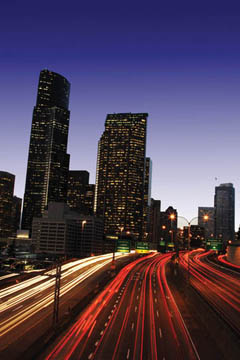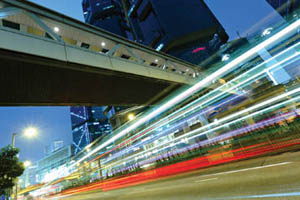
In 2001, the average American household spent more than two and a half hours (or 161 person-minutes) per day in a car to accomplish travel that required only 147 minutes in 1995. Multiplying by households and working days, we find that U.S. households used about 5 billion more hours in 2001 than in 1995 to accomplish the same amount of routine daily travel.
A fundamental law of road congestion: Adding 10 percent more lane miles to a city increases vehicle miles traveled by 10 percent.
Gilles Duranton and I recently examined the effect on traffic of changes in transportation infrastructure in U.S. cities. We found that expanding either road or transit networks is unlikely to reduce traffic congestion. In spite of this, carefully selected improvements to the highway network probably do pass a cost–benefit test, as does an across-the-board expansion of bus service. In addition, our results suggest that small tolls, tied to specific times of day, are likely to dramatically reduce traffic congestion. Finally, because about one-third of U.S. carbon emissions from energy consumption results from road travel, our findings illuminate an important link between infrastructure investments and carbon emissions.
A Fundamental Law of Road Congestion
To understand the effect of transportation infrastructure on traffic in cities, we assembled data describing the road network and travel behavior in all U.S. metropolitan areas containing interstate highways for 1980, 1990, and 2000. These data suggest a fundamental law of road congestion: Adding 10 percent more lane miles to a city increases vehicle miles traveled by 10 percent. That is, in less than 10 years, new roads cause traffic increases directly proportional to the increase in capacity. This law appears to hold for major urban roads, nonurban interstate highways near major cities, and urban interstates.
The additional traffic caused by a new road has three principal sources. Of these, an increase in driving by current city residents is the most important. In addition, a 10 percent increase in the extent of the interstate network appears to result in about a 20 percent increase in truck traffic (the increase in truck traffic is less important for other roads). We also find that people migrate to cities well provided with roads. Surprisingly, new roads seem not to cause substantial decreases in traffic on old roads.
We also examined the relationship between public bus service and vehicle miles traveled. Changes in a city’s stock of buses have no measurable effect on traffic in the city. Increases in the supply of public transit appear to operate in much the same way as road capacity increases do: Every person who gets out of their car and onto a bus creates some extra capacity on the road (the capacity they used previously). This sort of increase has exactly the same effect as increases in the extent of the road network: in less than 10 years it is filled up to its initial level. This suggests that adding public transit increases the ability of existing roads to produce person travel miles but does not reduce vehicle travel miles.
When Are Investments Worthwhile?
Other researchers sometimes assert that if roads induce demand for travel, then building roads is bad policy. To understand the flaw in this reasoning, consider an analogous statement about shoes: “If we make more shoes then people will wear every pair, therefore we should not make them.” In fact, the decision to make more shoes ought to hinge on how much it costs to make them and on the benefit accruing to their wearers. So too with roads. To calculate the benefits of new roads, we estimate the relationship between the demand for travel and the speed of this travel. Because one of the main costs of car travel is time, this demand relationship reveals what people are willing to give up (time) to accomplish a given amount of travel.
Reductions in travel time caused by an average highway expansion are not sufficient to justify the expense of such an expansion.
Our research tells us that the amount of automobile travel in a city is very sensitive to the time cost of this travel: People are willing to give up a lot of travel for a small reduction in their travel time. This finding is important for two reasons. First, it implies that the value of reduced travel time associated with a modest across-the-board expansion of the interstate highway network will probably not be equal to the costs of such an expansion. (The possibility that road investments will be justified by other benefits, such as allowing the city to grow beyond its current level, is a subject of current research.) Second, that the demand for car travel is sensitive to the price of this travel suggests that charging drivers a small fee to access roads at congested times should be expected to have a big impact on their demand for travel.
The fact that public transit does not reduce road travel also does not imply that buses do not make cities sufficiently nicer and more productive to justify its cost. We investigated the effects of changes in a city’s stock of roads and large buses on population and employment, and it appears that across-the-board improvements in bus service easily generate enough benefits to cover their costs.
Policy Implications
First, two commonly suggested responses to traffic congestion—expansions of the road and public transit network—do not appear to have their desired effect: Road and public transit expansions should not be expected to reduce congestion. Second, traffic levels do not help to predict which cities build roads. Therefore, new roads allocated to metropolitan areas on the basis of current rules are probably not built where they are most needed, which suggests that more careful reviews of highway expansion projects be required. Third, reductions in travel time caused by an average highway expansion are not sufficient to justify the expense of such an expansion. Whether or not other benefits of these expansions may justify their expense remains unresolved. In any case, expansions of the bus network are more likely to pass a cost–benefit test than expansions of the highway network.
Finally, we found that the demand for vehicle miles traveled is very responsive to price. This suggests that small “time of day” congestion charges will have large impacts on travel behavior. That is, unlike expansion of road or public transit networks, which do not appear to reduce traffic, congestion pricing should be expected to do so.
Reprinted with permission from Resources for the Future.




